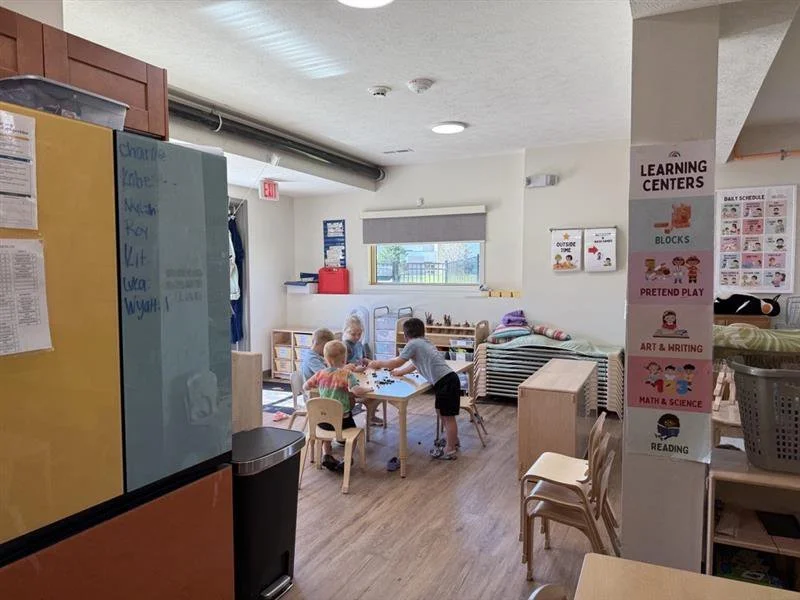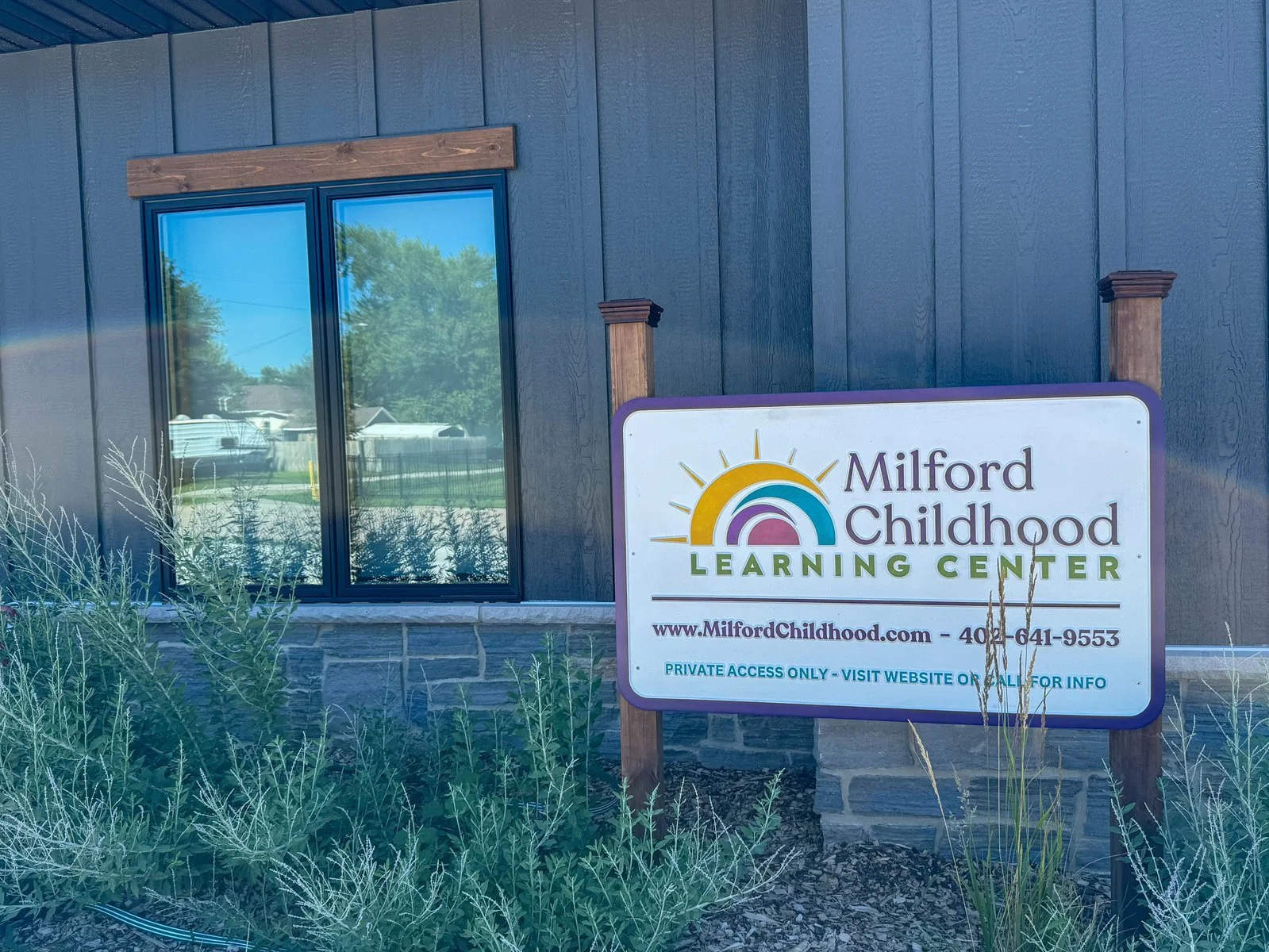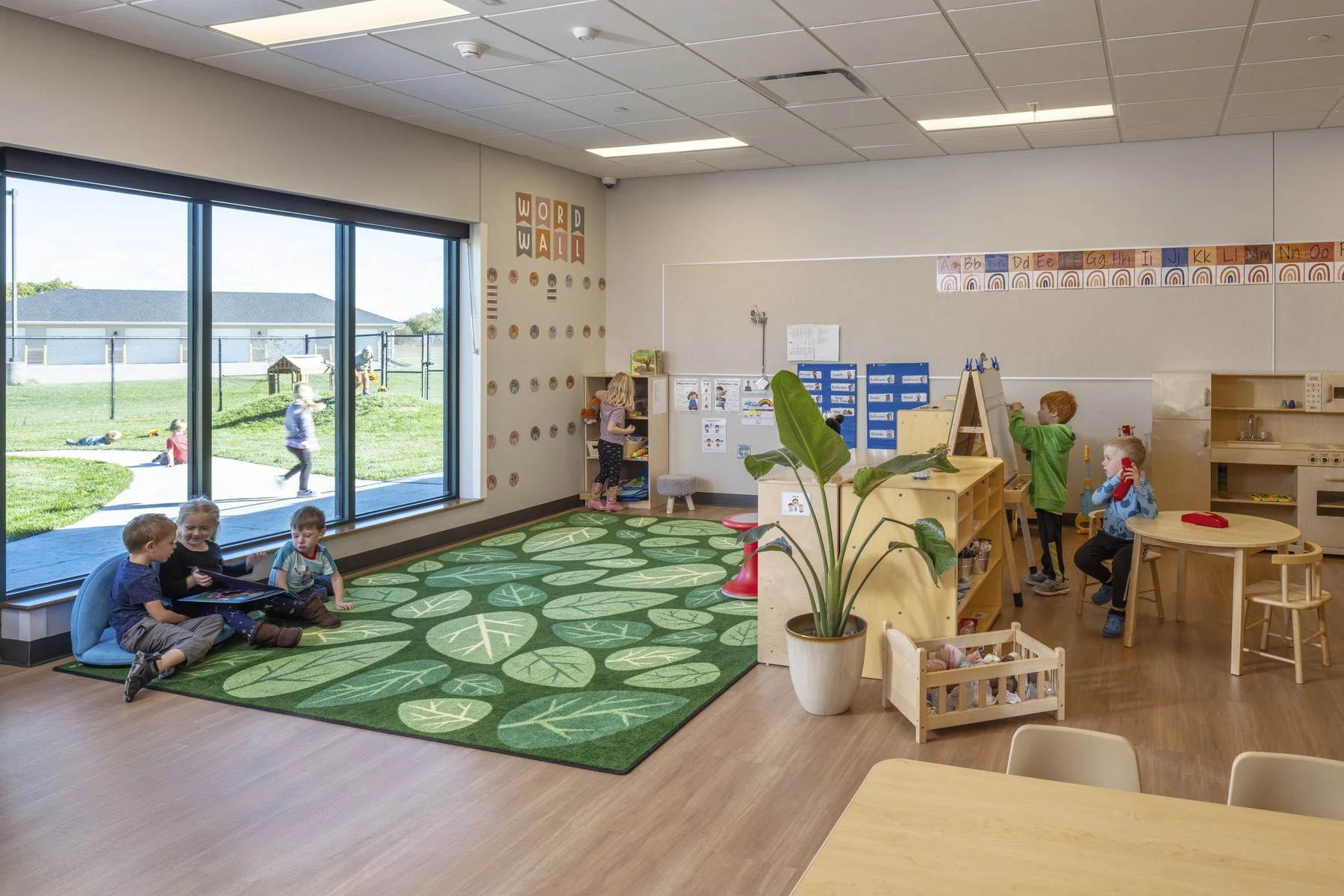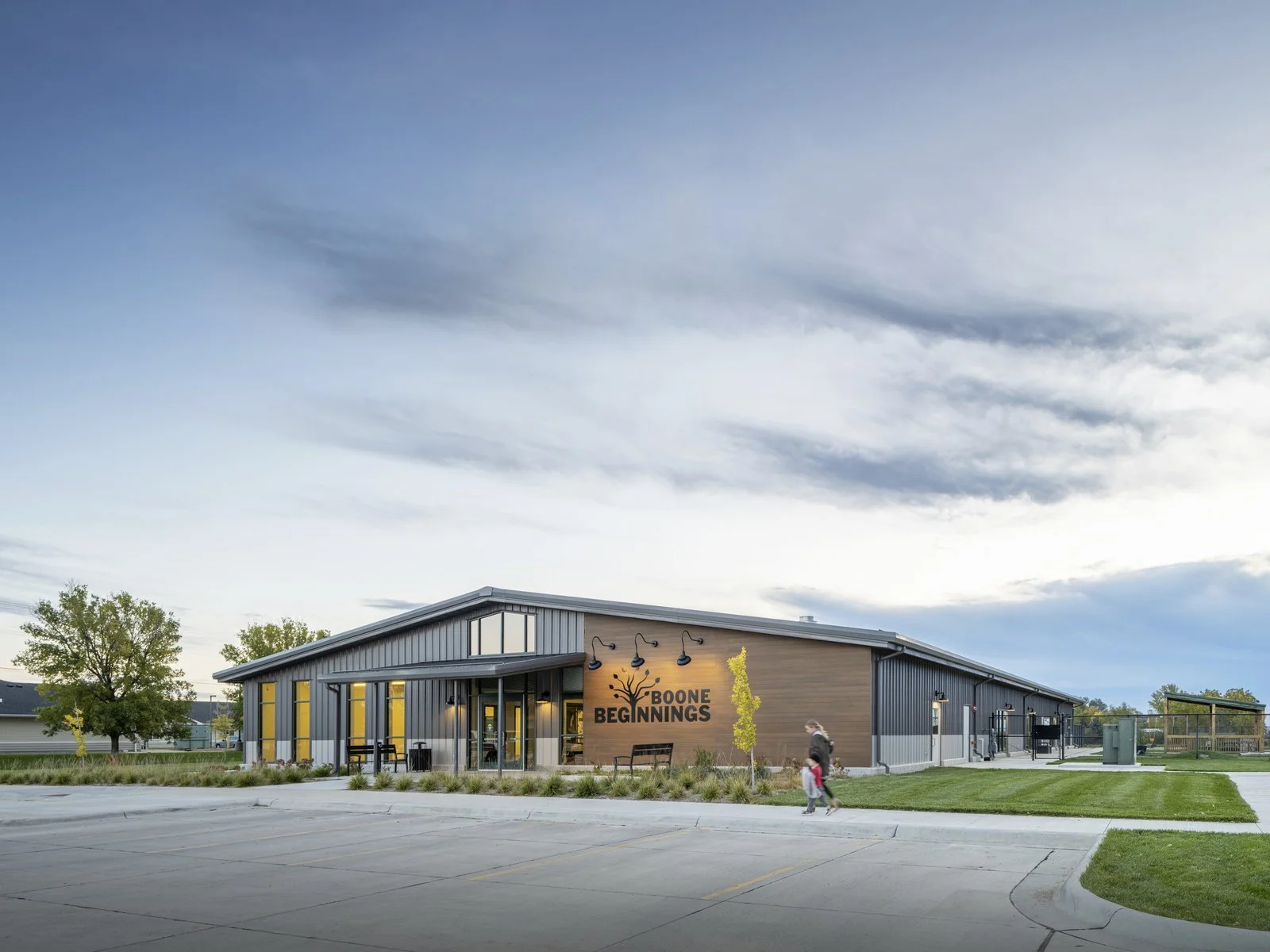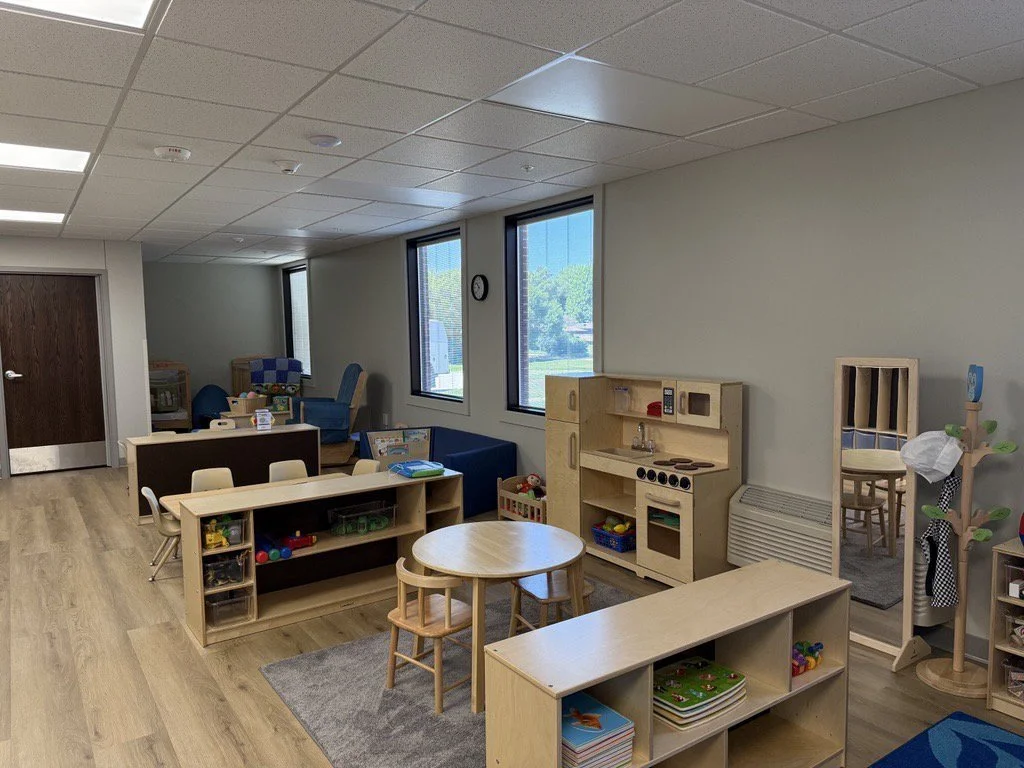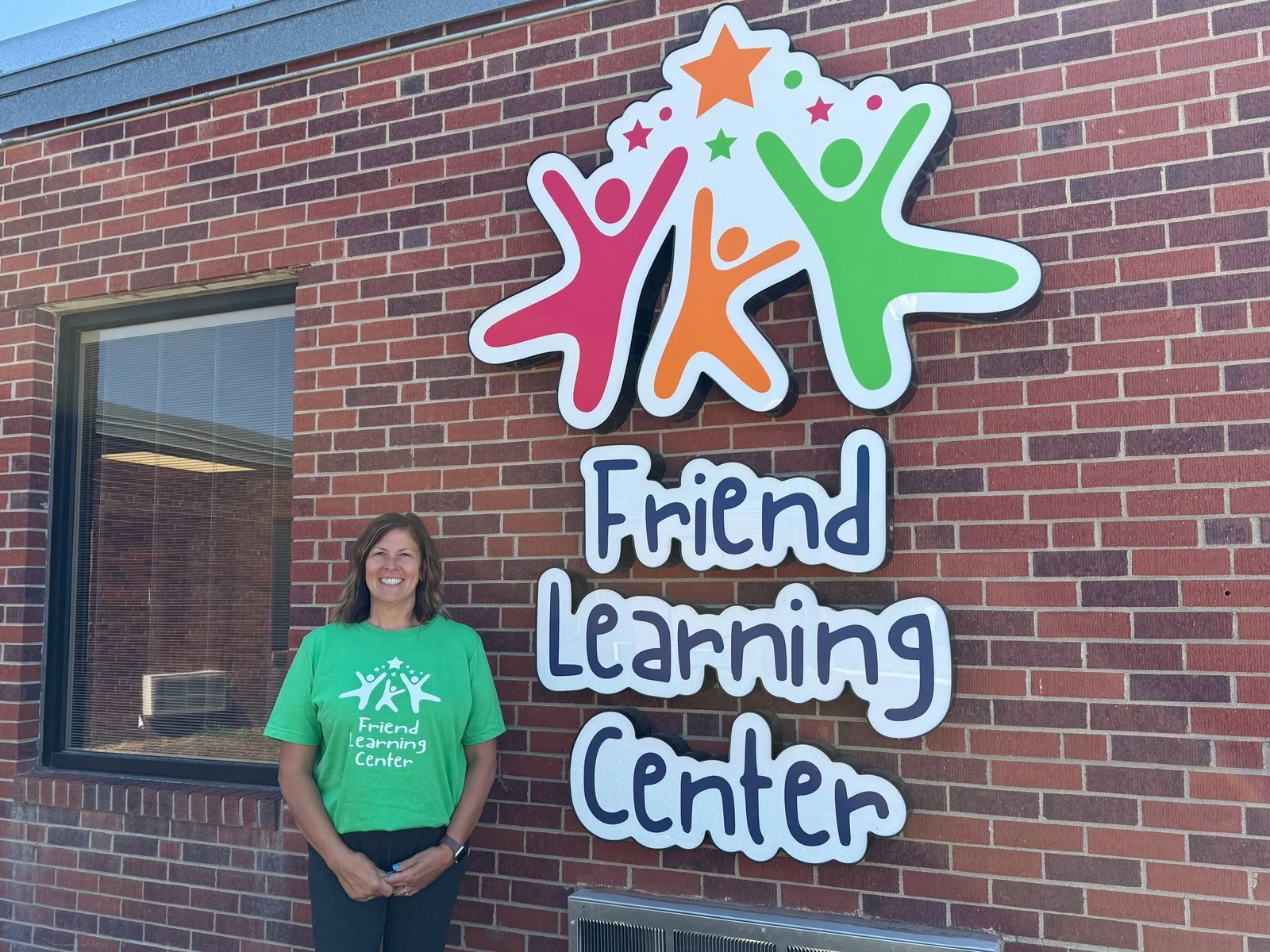Communities Get Creative to Tackle Child Care Shortage in Nebraska
By Jolie Peal, Reporter at Nebraska Public Media News | July, 28, 2025
Children at the Milford center work on a project in their classroom. Like many centers, the young students learn and play during the day. (Photo by Jolie Peal/Nebraska Public Media News)
Teachers at Milford Childhood Learning Center currently care for 35 children and are expecting 10 more in the fall. Students spend their days playing, learning and doing art projects.
Samantha Ahlers is director of the center, and her two children are enrolled. She said the center has become a community of its own.
“[It’s] heartwarming that my kids would be able to grow up with friends their own age,” Ahlers said with tears in her eyes. “I mean, just seeing everyone grow up together. It’s a big community thing.”
Milford Childhood Learning Center opened in June 2024. It was funded through a state grant, city money and donations. (Photo by Jolie Peal/Nebraska Public Media News)
The Milford center has been open since June 2024. It was born out of a need for child care in the community. Kylie Schildt, former MCLC program coordinator, said she took on whatever role was needed to make the project come to life.
“I was honestly just a mom that didn't have access to local child care and was really struggling to find solutions for my family,” Schildt said. “I took it on myself to look into what different solutions other communities like mine were looking towards, and what types of resources were available through the state and through nonprofits and evaluating what a good solution would look like for Milford.”
In Nebraska, more than 12,000 spaces are needed to fill the child care gap, according to U.S. Census and Nebraska Department of Health and Human Services data. Solving the shortage isn’t a “one-size-fits-all” approach.
In Milford, the community received a state grant, city money and donations from community members. A church offered the land for $1 on a 50-year lease, and Schildt said the building was bought from the local community college as part of a class where students construct a house.
Rachel Sissel, associate vice president of early childhood for Communities for Kids, said her organization helps communities across Nebraska find the path that works best for them. The organization provides a $30,000 grant over a three-year period and planning support throughout.
“There are communities that have hosted community-wide events,” Sissel said. “There are communities that have engaged in strategic planning processes. There are communities who have offered current providers grants to make sure that they have high-quality materials, that they're maintaining licensing compliance, that they're pursuing trainings that they might be interested in — so it's really up to the community on how they use the funds and our time with them.”
Sissel said an important ingredient to success has been engagement, especially with people who aren’t directly involved in the child care sphere. She added that child care shortages impact more than families — fewer child care spots means fewer people in the workforce and fewer people staying in the community.
“It feels like there's been a little bit of a needle shift because the engagement that we have now are from superintendents, from economic development associations, from the hospital CEO coming and recognizing the impact that it has on workforce,” Sissel said. “Families are getting vocal and saying, ‘Hey, we need this.’ It's not only a functional service to live in the community, it's an essential one.”
According to Census data, more than 100,000 Nebraska children under age 6 have all available parents in the work force. A policy brief from The Buffett Early Childhood Institute said that the potential need for child care has gone down in recent years due to fewer women in the labor force.
Lindsey Jarecki, a mom and former board member for Boone Beginnings, said child care impacts everyone in a community. (Photo courtesy Lindsey Jarecki)
Lindsey Jarecki, a mom and former board member for child care center Boone Beginnings in Boone County, said she had to pass up a job at the local school because there was a lack of child care. It ultimately led to her devoting eight years to creating and growing child care options in her community.
“It was frustrating to me that I was like, I can't even apply for this job that I want because there just were no spots at that moment for a baby.” Jarecki said. “It changed my career path, but the path of the conversation, too.”
Jarecki said it wasn’t just parents advocating for more child care. With the impact on the work force, a cattle rancher contributed funding and his expertise to make the center happen.
Boone Beginnings opened in 2021. The center has two infant rooms, two toddler rooms and two preschool rooms. (Photo courtesy Lindsey Jarecki)
“He is a cattle rancher nearing retirement, and so he is not your likely culprit,” Jarecki said. “That's kind of cool because it opened up the door for other people who didn't think they had a seat at the table to recognize, ‘Oh, I do have a seat at the table here. This impacts me.’”
Jarecki added that even if people couldn’t donate money, they would donate their time or skills. One person installed a sprinkler system and another helped write "thank you" cards.
Howells, a community in eastern Nebraska, has a similar story. Laura Mejstrik, co-director at Howells Little Angels Child Care Center, said there are several retired community members with early childhood experience who help out. One of them offers a 16-week curriculum to prepare students for preschool — things like raising their hand, sitting correctly in a chair and how to hold a pencil.
“It sounds silly, but when you have that small instruction before you go to school — school is a lot less daunting,” Mejstrik said. “It's a lot easier transition.”
Little Angels Child Care Center in Howells opened after the directors of the two in-home centers retired. Pictured here is a swing set that community members helped fund for the center. (Photo courtesy Laura Mejstrik)
The Howells community converted the old school house into a child care center in 2021 after they found out the two in-home providers were retiring. Without child care, Mejstrik said young families will choose to move elsewhere. She sees it as a lifeline for a community’s future.
“By offering child care, we're staying ahead of the curve, so to speak,” Mejstrik said. “That's kind of what it means. It means we're going to thrive and never cease to exist.”
Another challenge facing child care is staying affordable while paying early childhood educators for their work. According to the First Five Years Fund, Nebraska child care workers make around $29,100 annually.
Meanwhile, families paid anywhere from $7,500 to almost $13,000 in child care costs in a year — sometimes surpassing what it costs for a resident student to attend the University of Nebraska-Lincoln, which is around $10,000.
Mejstrik cited an article she heard about child care being as important to invest in as college because focusing on those early years sets up a child for success later in life.
“We don't want people to live paycheck to paycheck, but at the same token, the services we provide are very much worth the money that it costs for the child to come here,” Mejstrik said.
Sissel with Communities for Kids said early childhood education is when a child learns the most. By age 5, a child’s brain is 90% developed.
“The reason why I think it’s so important is because this is the beginning of the pipeline for public education,” Sissel said. “This is the time when children are developing at the most rapid rate. The teachers that are teaching them in early care classrooms have such an impactful role within those children's lives.”
Child care is both a tough and rewarding job, said Amy Kucera, executive director of Merrick County Child Development in Central City.
“It is a foundation of our communities,” Kucera said. “We are, in my opinion, the most important job there is because we are taking care of not only the future of our community, but also the most important thing in every single person's lives that's in the workforce — their children.”
Merrick County Child Development has been open more than two decades. (Photo by Jolie Peal/Nebraska Public Media News)
The Merrick County Child Development center has been open since 2001. Kucera sees sustainability as a crucial component to ensuring the child care gap doesn’t continue to grow.
“A lot of these ones that have been open through funding and grants in the past five years, that money is slowly fading out,” Kucera said. “The plan for sustainability for the future is not always there. I think that's where our focus needs to be, as far as staffing and funding to sustain the child care centers, because it just is not a money-making business.”
While the Merrick County facility has helped with the child care gap in the area, Katie Benner, a board member for the center, said the lack of in-home providers means there still aren’t enough spots.
“No one's wanting to start a licensed in-home,” Benner said. “No one wants to open themselves up to inspections and liability.”
Benner said having both in-home facilities and centers also gives families options to find the best fit for their child.
Finding that best fit could be more than just deciding to enroll in an in-home or center. In Fremont, Elida Canjura opened Ely Children Care in Fremont this month to help fill a need for a Hispanic child care center.
“Y dije qué raro que en ese pueblo sí habían muchos day cares, pero todos americanos. Y luego nació la idea. Y con esa idea dije, tengo que hacer algo,” Canjura said.
[“And I said it’s odd that this town has so many day cares, but all of them are English-speaking. And then the idea was born. And with this idea I said I have to do something.”]
Daycare owner and former teacher Elida Canjura poses for a photo in her home the day of her childcare opening, Friday, July 18, 2025. (Photo by Kassidy Arena/Nebraska Public Media News)
Canjura experienced the need for a Hispanic center herself. Now, she is both creating more child care spots in her community while also creating a service for the more than 19% of Fremont residents who identify as Hispanic or Latino.
“Me llena el corazón cuando ellos me dicen a mí no me dicen maestra, no me dicen mis, me dice mamá," she said.
["It fills my heart when they don’t call me teacher, they don’t call me Miss, they call me mom.”]
In Friend, almost an hour southwest of Lincoln, Stacy Lawver is looking forward to welcoming families to the Friend Learning Center. She’ll be director of the new facility. There was a different center for 20 years in the city of about 950 people, but when it closed, the community came together to ensure there was still access to child care.
Friend Learning Center is set to open in August. It's located in what used to be the community's nursing home. (Photo by Jolie Peal/Nebraska Public Media News)
“I’ve seen them take a good three, four years, five years to get all of the funds to make this happen,” Lawver said. “Our community had the funds between the grants and the donations, we were able to get going within about two years, since this has all started.”
The center is in the back of the local hospital. Lawver said she spent a lot of time there growing up with her mom, who was head of the cleaning department, and then later as a certified nursing assistant.
“I grew up in this facility, so it’s just like a full circle of, I’m back here,” she said.
Currently, 27 kids are enrolled ahead of the center opening in early August. At full capacity and staffing, the center could hold 48 children across four rooms.
Lawver said the child care shortage is a problem everywhere. She hears from her friends and her daughter in Minnesota who share similar challenges.
Friend Learning Center was born after the previous child care center in the community closed. It is set to open in early August. (Photo by Jolie Peal/Nebraska Public Media News)
“It takes two people to work anymore, to make a living with our economy and the way life is,” Lawver said. “The importance of having a safe and nurturing environment for people to bring their children so both parents can go to work and make their household work is a huge asset to any community.”
She is looking forward to continuing to do her part to take care of the children in her community, some of whose parents she helped teach when they were kids, Lawver said. She spent 32 years as an in-home provider before deciding to lead the new center.
“I love it,” she said. “Their mom and dad still come in, and they still remember things from when they were little, so it’s fun.”
View the article online at: Communities get creative to tackle child care shortage in Nebraska | Nebraska Public Media

